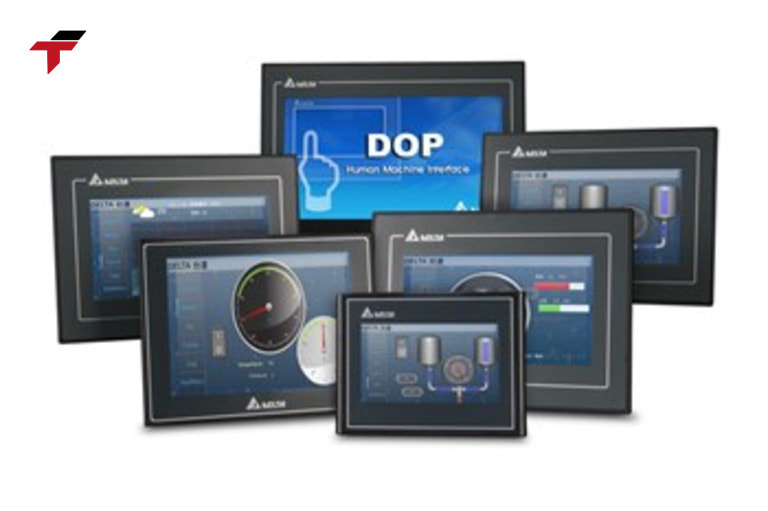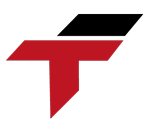HMI Touch Panel is an advanced human-machine interface that allows seamless interaction between operators and automation systems. Instead of using multiple mechanical buttons or switches, all control and monitoring tasks can now be performed simply through a few touches on the screen. This article from Flextech provides a detailed overview of HMI Touch Panels, including their structure, how they operate, and key factors to consider when selecting the right device for industrial applications.
What is HMI Touch Panel?
HMI Touch Panel (Human-Machine Interface) is a touchscreen interface that enables operators to monitor, control, and interact directly with machinery, production lines, or entire automation systems.
Compared to traditional mechanical control panels with physical buttons and indicator lights, HMI Touch Panels offer:
- Intuitive operation through graphical interfaces, charts, and virtual buttons.
- Quick parameter adjustments and real-time monitoring via touchscreen input.
- The ability to consolidate multiple control functions into a single compact device, reducing wiring complexity and saving space.
Modern HMIs can display detailed data, trends, alarms, and system statuses in real time, allowing operators to make informed decisions instantly.
What is the structure of an HMI Touch Panel?
A standard HMI Touch Panel is designed to integrate multiple functions into a single device, allowing operators to interact intuitively with automation systems. It typically consists of three main components, each playing a crucial role in the operation and reliability of the interface:
Touchscreen
- The touchscreen serves as both the display and the input interface of the HMI. It shows real-time information, including machine status, production data, process parameters, charts, alarms, and warnings.
- Modern HMI panels often use capacitive or resistive touch technologies, which allow precise detection of user inputs such as taps, swipes, or multi-touch gestures.
- The screen layer is responsible for detecting the exact touch position and transmitting that information to the control board for processing. High-resolution touchscreens ensure clarity of displayed data and reduce operator errors.
Control Board
- Acting as the “brain” of the HMI, the control board processes touch inputs, runs the HMI software or interface program, and manages the internal communication between components.
- It interprets user commands, updates the interface dynamically, and converts input signals into actionable commands sent to connected devices like PLCs, inverters, or I/O modules.
- The control board also stores configuration settings, interface layouts, and historical data, enabling rapid response and smooth operation. In Flextech HMIs, the control board is optimized for industrial environments, ensuring stable performance under high vibration or temperature conditions.
Communication Module
- This module enables seamless data exchange between the HMI and external automation devices, supporting multiple industrial communication protocols such as Ethernet, RS232, RS485, Modbus TCP/RTU, and Profibus.
- It ensures accurate, real-time transmission of control commands and feedback signals. Advanced communication modules also include built-in error checking, signal buffering, and protocol conversion to maintain stable connectivity even in noisy industrial environments.
- In high-demand systems, the communication module ensures synchronized operation between the HMI and several devices simultaneously, reducing latency and minimizing control errors.

A standard HMI Touch Panel is designed to integrate multiple functions into a single device
How does the HMI Touch Panel work?
To ensure that the HMI Touch Panel operates smoothly and ensures that data between humans and machines is always transmitted accurately, the internal process is organized into many consecutive steps. Understanding each step will help engineers easily install, check and handle errors when necessary. Below are the 5 steps of the HMI Touch Panel operation:
Step 1: Capture touch operations
The operator touches the touch screen directly (selects buttons, enters values, adjusts parameters, etc.). The touch layer will detect the touch position and transfer that signal to the control board.
Step 2: Process command signals
The control board will process the operation data using pre-programmed HMI software. This operation can be sending control commands, changing setting values or activating a specific process.
Step 3: Send command to control device
The processed signal will be sent through the communication module, transmitted to other control devices such as PLC, inverter or I/O module via communication standards (Ethernet, RS485, Modbus …).
Step 4: Receive feedback data
After executing the command, the control device (PLC, inverter …) will send feedback data (machine status, sensor value, warning …) back to HMI via the established transmission line.
Step 5: Display visual information
HMI Touch Panel will update and display feedback data on the screen in the form of numbers, charts, warnings … Helping operators monitor and make timely decisions.
What benefits does an HMI Touch Panel bring to businesses?
Thanks to its modern design and advanced touch technology, the HMI Touch Panel offers many outstanding benefits compared to traditional control panels. Below are the outstanding advantages that make this device increasingly popular in automation systems.
- Easy and intuitive operation: Thanks to the touch screen displaying a variety of information through graphics, charts and virtual buttons, the operator only needs to lightly touch to monitor and control the device. The intuitive interface helps reduce operating errors and shorten worker training time.
- Save installation space: Compared to traditional mechanical control panels with a series of buttons and indicator lights, the HMI Touch Panel integrates everything in one. This makes the electrical cabinet neater, reduces wiring, reduces construction costs, and is easy to arrange in different positions on the production line.
- Easy programming & expansion: The HMI Touch Panel allows engineers to design the interface, add or remove features or change the display structure through programming software. When expansion is needed, just update the program instead of changing complex hardware.
- Flexibility in changing interface design: HMI Touch Panel allows updating new display screens, changing button layouts, charts or adding features without interfering with the wiring or main board.
- Easy integration with remote monitoring systems: In addition to direct operation, many modern HMI Touch Panel lines also support LAN or Internet connection, allowing managers to monitor remotely via computer or phone.

Benefits an HMI Touch Panel bring to businesses
What are the notes when choosing HMI Touch Panel?
For HMI Touch Panel to maximize its effectiveness, businesses need to consider many important factors before investing. Below are the points to note when choosing the right device for actual needs and operating environment.
- Suitable size & resolution: A screen that is too small will be difficult to observe details, a screen that is too large will waste investment costs. In addition, resolution is also important – a sharp screen helps display charts and parameters clearly, easy to operate.
- Communication standards: Each automation system can use different protocols such as Ethernet/IP, RS232, RS485, Modbus RTU/TCP, Profibus… Therefore, it is necessary to choose an HMI that fully supports the communication standards in use.
- Installation environment: In industrial factories, the environment is often dusty, humid, has strong vibrations or electromagnetic interference from large capacity devices. Therefore, the HMI should have dustproof, waterproof standards (IP65 or higher), durable housing, and well-protected circuit boards to ensure long-term stable operation.
- Reputable manufacturers & technical services: Choosing HMI Touch Panel from reputable brands such as XINJE will help ensure quality, durability and compatibility with other control devices (PLC, inverter, SCADA).

4 notes when choosing HMI Touch Panel
Conclusion
HMI Touch Panel is no longer just an advanced option — it has become an essential component in modern automation systems. With its intuitive operation, compact design, and high flexibility in customization, the HMI Touch Panel helps optimize control efficiency and enhance the interaction between humans and machines.
To ensure stable and long-lasting operation, businesses should carefully select HMIs that match their production environment, communication standards, and system requirements. Understanding how the device works — from structure to operating principles — allows engineers to make the right investment decisions, reduce downtime, and improve productivity.
At Flextech, we provide high-quality HMI Touch Panels and complete automation solutions that integrate seamlessly with PLCs, inverters, and motion control systems. With a focus on reliability and industrial performance, Flextech helps businesses build smarter, safer, and more efficient production environments — ready to scale and adapt to future technological demands.


